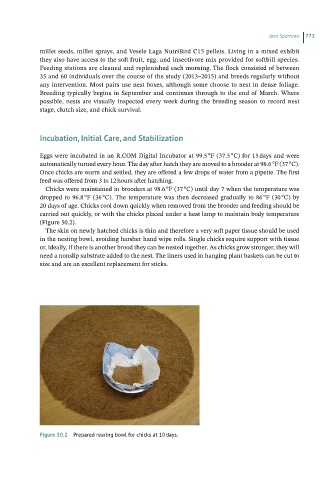Page 770 - Hand rearing birds second
P. 770
Java Sparrows 773
millet seeds, millet sprays, and Vesele Laga NutriBird C15 pellets. Living in a mixed exhibit
they also have access to the soft fruit, egg, and insectivore mix provided for softbill species.
Feeding stations are cleaned and replenished each morning. The flock consisted of between
35 and 60 individuals over the course of the study (2013–2015) and breeds regularly without
any intervention. Most pairs use nest boxes, although some choose to nest in dense foliage.
Breeding typically begins in September and continues through to the end of March. Where
possible, nests are visually inspected every week during the breeding season to record nest
stage, clutch size, and chick survival.
Incubation,InitialCare,and Stabilization
Eggs were incubated in an R.COM Digital Incubator at 99.5 °F (37.5 °C) for 15 days and were
automatically turned every hour. The day after hatch they are moved to a brooder at 98.6 °F (37 °C).
Once chicks are warm and settled, they are offered a few drops of water from a pipette. The first
feed was offered from 3 to 12 hours after hatching.
Chicks were maintained in brooders at 98.6 °F (37 °C) until day 7 when the temperature was
dropped to 96.8 °F (36 °C). The temperature was then decreased gradually to 86 °F (30 °C) by
20 days of age. Chicks cool down quickly when removed from the brooder and feeding should be
carried out quickly, or with the chicks placed under a heat lamp to maintain body temperature
(Figure 50.2).
The skin on newly hatched chicks is thin and therefore a very soft paper tissue should be used
in the nesting bowl, avoiding harsher hand wipe rolls. Single chicks require support with tissue
or, ideally, if there is another brood they can be nested together. As chicks grow stronger, they will
need a nonslip substrate added to the nest. The liners used in hanging plant baskets can be cut to
size and are an excellent replacement for sticks.
Figure 50.2 Prepared rearing bowl for chicks at 10 days.

